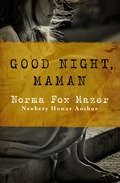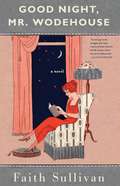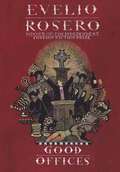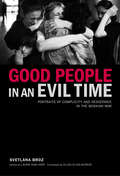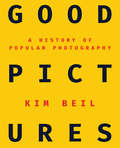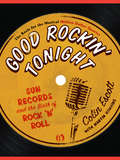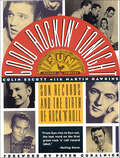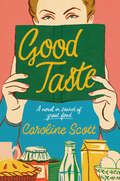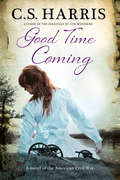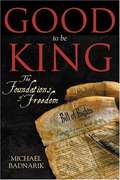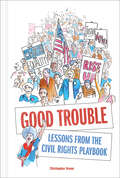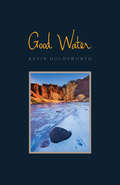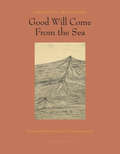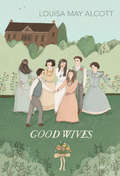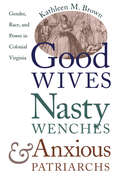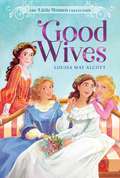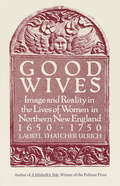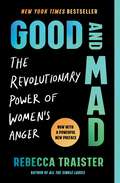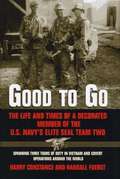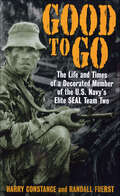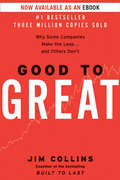- Table View
- List View
Good Night, Maman (Harper Trophy Bks.)
by Norma Fox MazerEscaping from the terrors of World War II, Karin gets the chance for a new life in America--but she can't stop thinking about her mother, who she left behind in France Karin Levi's life in Paris was happy and normal. She never dreamed she would find herself hiding in a cramped attic with her family, sitting silently while police went from house to house hunting for Jews and turning them over to German soldiers. Hopeless and scared, only Maman's loving smile and caring touch give Karin the strength to keep going. But soon, Karin and her older brother, Marc, must flee the attic, crossing land and sea in search of safety, and leaving Maman behind. Longing for her mother and a return to their happy life, Karin expresses her love in letters she won't be able to send until the war is over. Dearest Maman . . .
Good Night, Mr. Wodehouse: A Novel
by Faith Sullivan“More than forty years of history bookend a lifelong love affair with reading for the resilient heroine of [this] novel set in Harvester, Minnesota.” —Kirkus ReviewsA Wall Street Journal Top 10 Book of the YearWhen Nell Stillman’s boorish husband dies soon after they move to the small town of Harvester, Minnesota, Nell is alone, penniless yet responsible for her beloved baby boy, Hillyard. Not an easy fate in small-town America at the beginning of the twentieth century.In the face of nearly insurmountable odds, Nell finds strength in lasting friendships and in the rich inner life awakened by the novels she reads. She falls in love with John Flynn, a charming congressman who becomes a father figure for Hillyard. She teaches at the local school and volunteers at the public library, where she meets Stella Wheeler and her charismatic daughter Sally. She becomes a friend and confidant to many of the girls in town, including Arlene and Lark Erhardt. And no matter how difficult her day, Nell ends each evening with a beloved book, in this novel that celebrates the strength and resourcefulness of independent women, the importance of community, and the transformative power of reading.“Sullivan describes small-town life through the eyes of an intelligent, generous narrator who fights off gossip, pettiness and tragedy with compassion, perseverance and forgiveness. Who wouldn’t want to spend a late-summer afternoon or two in the company of such a person?” —Minneapolis Star-Tribune“Her novels are a reliably inviting world, full of friendly faces and intimate dramas. However you first make your way to Harvester, you’ll want to return.” —The Wall Street Journal“[An] inspiring novel, which should find its way onto the reading lists of book clubs.” —Publishers Weekly
Good Offices
by Evelio RoseroWhen Father Almida is summoned to an audience with the parish's principal benefactor, a stand-in is found in Father Matamoros, a drunkard with an angel's voice whose sung mass is mesmerizing to all. But Matamoros hides a darker side, and when the church's residents throw a feast for him he encourages them to lose all their inhibitions and give free reign to their most Bacchanalian desires. A satire on the iniquities of the Catholic church in Colombia, Good Offices is at once comic, surreal and startling, a novel that will linger long in the mind.
Good Offices
by Evelio RoseroWhen Father Almida is summoned to an audience with the parish's principal benefactor, a stand-in is found in Father Matamoros, a drunkard with an angel's voice whose sung mass is mesmerizing to all. But Matamoros hides a darker side, and when the church's residents throw a feast for him he encourages them to lose all their inhibitions and give free reign to their most Bacchanalian desires. A satire on the iniquities of the Catholic church in Colombia, Good Offices is at once comic, surreal and startling, a novel that will linger long in the mind.
Good People in an Evil Time: Portraits of Complicity and Resistance in the Bosnian War (Ethnographies Of The Present Ser.)
by Svetlana BrozIn the 1990s Svetlana Broz, granddaughter of former Yugoslav head of state Marshal Tito, volunteered her services as a physician in war-torn Bosnia. She discovered that her patients were not only in need of medical care, but that they urgently had a story to tell, a story suppressed by nationalist politicians and the mainstream media. What Broz heard compelled her to devote herself over the next several years to the collection of firsthand testimonies from the war. These testimonies show that ordinary people can and do resist the murderous ideology of genocide even under the most terrible historical circumstances. We are introduced to Mile Plakalovic, a magnificent humanist, who drove his taxi through the streets of Sarajevo, picking the wounded up off the sidewalk and delivering food and clothing to young and old, even when the bombing was at its worst. We meet Velimir Milosevic, poet, who traveled with an actor and entertained children as they hid in basements to avoid the bombing and gunfire, and we hear the stories of countless others who put themselves in grave danger to help others, regardless of ethnic background. Faced with a world in which unspeakable crimes not only went unpunished but were rewarded with glory, profit, and power, the Bosnians of all faiths who testify in this book were starkly confronted with the limits and possibilities of their own ethical choices. Here, in their own words they describe how people helped one another across ethnic lines and refused the myths promoted by the engineers of genocide. This book refutes the stereotype of inevitable natural enmities in the Balkans and reveals the responsibility of individual actions and political manipulations for the genocide; it is a searing portrait of the experience of war as well as a provocative study of the possibilities of resistance and solidarity. The testimonies reverberate far beyond the frontiers of the former Yugoslavia. This compelling book is essential reading for anyone who wants to understand the reality on the ground of the ethnic conflicts of the late twentieth and the twenty-first centuries.
Good Pictures: A History of Popular Photography
by Kim BeilA picture-rich field guide to American photography, from daguerreotype to digital. We are all photographers now, with camera phones in hand and social media accounts at the ready. And we know which pictures we like. But what makes a "good picture"? And how could anyone think those old styles were actually good? Soft-focus yearbook photos from the '80s are now hopelessly—and happily—outdated, as are the low-angle portraits fashionable in the 1940s or the blank stares of the 1840s. From portraits to products, landscapes to food pics, Good Pictures proves that the history of photography is a history of changing styles. In a series of short, engaging essays, Kim Beil uncovers the origins of fifty photographic trends and investigates their original appeal, their decline, and sometimes their reuse by later generations of photographers. Drawing on a wealth of visual material, from vintage how-to manuals to magazine articles for working photographers, this full-color book illustrates the evolution of trends with hundreds of pictures made by amateurs, artists, and commercial photographers alike. Whether for selfies or sepia tones, the rules for good pictures are always shifting, reflecting new ways of thinking about ourselves and our place in the visual world.
Good Rockin' Tonight
by Colin Escott Martin HawkinsRock 'n' roll was born in Memphis in the tiny storefront recording studio of Sun Records. <P><P>This is the definitive account of how it happened! Sam Phillips's credo was: "If you're not doing something different, you're not doing anything." <P> If he had done no more than discover Elvis Presley and produce his first five singles he would still be the godfather of rock 'n' roll. But he did more. <P>Much more. While Elvis was still sitting on the edge of his bed listening to the radio and figuring out guitar chords, Phillips was discovering and recording blues giants like B.B. King, Howling Wolf, and Ike Turner. <P>During the few months that Elvis was with Sun Records, Phillips found Johnny Cash and Carl Perkins. Soon after, he found Jerry Lee Lewis, Roy Orbison, and Charlie Rich. <P>And he did it almost singlehandedly--from his two-room studio in Memphis, Tennessee. <P> Phillips's story, which Colin Escott tells in beautiful detail, is more than a catalog of hits. <P>Without Sun's philosophy of experimentation, innovation, and genre transcendence, the musical revolution could have never begun.
Good Rockin' Tonight: Sun Records and the Birth of Rock 'N' Roll
by Colin Escott Martin HawkinsMemphis, Tennessee. The early 1950s. The Mississippi rolls by, and there's a train in the night. Down on Beale Street there's hard-edged blues, on the outskirts of town they're pickin' hillbilly boogie.At Sam Phillips' Sun Records studio on Union Avenue, there's something different going on. "Shake it, baby, shake it!" "Go, cat, go!" "We're gonna rock..."This is where rock 'n' roll was born-the record company that launched Elvis Presley, Jerry Lee Lewis, Johnny Cash, Roy Orbison, and Carl Perkins. The label that brought the world, "Blue Suede Shoes," "Whole Lotta Shakin' Goin' On," "Breathless," "I Walk the Line," "Mystery Train," "Baby, Let's Play House,' "Good Rockin' Tonight." Good Rockin Tonight is the history, in words and over 240 photographs, of Sam Phillips' legendary storefront studio, from the early days with primal blues artists like Howlin' Wolf and B.B. King to the long nights in the studio with Elvis and Jerry Lee. As colorful and energetic as the music itself, it's a one-of-a-kind book for anyone who wants to know where it all started.
Good Taste: A Novel in Search of Great Food
by Caroline ScottWith delectable prose, a sharp heroine ahead of her time, and an adventure across the English countryside in search of great food, Good Taste is the perfect historical novel for fans of Dear Mrs. Bird and The Guernsey Literary and Potato Peel Pie Society.You can tell a lot about a person from what they like to eat…England in 1932 is in the grip of the Great Depression. Stella Douglas, author of a much-loved but not very successful biography, is a bit depressed herself. When she’s summoned to see her editor in London, she expects her writing career is over before it’s even started.But much to her surprise, she is being commissioned to write a history of English food. It's to be quintessentially English and intended to lift the sprits of the nation. There's just one problem: a lot of English food is actually quite terrible (and anything good is usually imported from elsewhere). So Stella travels across England in hopes of discovering a hidden culinary gem. What she discovers is oatcakes and gravy and lots and lots of potatoes. But when her car breaks down midjourney and the dashing and charismatic antiques dealer Freddie springs to her rescue, she is led in a very different direction . . .Full of wit, life, and—against all odds—delicious food, Good Taste is a story of discovery and one woman’s desire to make her own way as a modern woman.
Good Time Coming: A Novel of the American Civil War
by C.S. HarrisA girl grows up too quickly in Civil War Louisiana: &“Powerful…This is top-notch historical fiction.&”—Publishers WeeklyI killed a man the summer I turned thirteen… Thus begins USA Today-bestselling author C. S. Harris&’s haunting, lyrically beautiful tale of coming of age in Civil War-torn Louisiana. Eleven-year-old Amrie St. Pierre is catching tadpoles with her friend Finn O&’Reilly when the Federal fleet first steams up the Mississippi River in the spring of 1862. With the surrender of New Orleans, Amrie&’s sleepy little village of St. Francisville—strategically located between the last river outposts of Vicksburg and Port Hudson—is now frighteningly vulnerable. As the roar of cannons inches ever closer and food, shoes, and life-giving medicines become increasingly scarce, Amrie is forced to grow up fast. But it is her own fateful encounter with a tall, golden-haired Union captain named Gabriel that threatens to destroy everything and everyone she holds most dear. Told with rare compassion and insight, this is a story of loss and survival; of the bonds that form among women and children left alone to face the hardships, depravations, and dangers of war; and of one unforgettable girl&’s slow and painful recognition of the good and evil that exists within us all. &“This story of love, loss, and growing up under some of the most difficult circumstances imaginable is beautifully written, superbly researched, emotionally engaging and gripping from first page to last. A must for old-school fans of historical fiction.&”—Booklist (starred review
Good Times, Bad Times: The Explosive Inside Story of Rupert Murdoch
by Harold EvansA renowned journalist&’s &“vivid&” account of his battle with Murdoch after the global media baron bought the Times of London (Chicago Tribune). In 1981, Harold Evans was the editor of one of Britain&’s most prestigious publications, the Sunday Times, which had thrived under his watch. When Australian publishing baron Rupert Murdoch bought the daily Times of London, he persuaded Evans to become its editor with guarantees of editorial independence. But after a year of broken promises and conflict over the paper&’s direction, Evans departed amid an international media firestorm. Evans&’s story is a gripping, behind-the-scenes look at Murdoch&’s ascension to global media magnate. It is Murdoch laid bare, an intimate account of a man using the power of his media empire for his own ends. Riveting, provocative, and insightful, Good Times, Bad Times is as relevant today as when it was first written. With details on the scandalous deal between Murdoch and Margaret Thatcher, this updated ebook edition includes an extensive new preface by Evans, the New York Times–bestselling author of Do I Make Myself Clear?, discussing the Rupert Murdoch phone-hacking scandal.
Good To Be King: The Foundation of Our Constitutional Freedom
by Michael BadnarikThroughout the book, Badnarik stresses the difference between rights and privileges, pointing out that our rights aren't granted by the government -- we possess them independently of government, so we don't need government permission to exercise our rights. He reminds the reader that we the people created the government, and it is supposed to work for us, not the other way around. The book also discusses how a government that was supposed to be severely limited has grown out of control on our watch, and offers some constructive suggestions for what to do about it. From the title, I thought Badnarik might be discussing the imperial presidency that has developed over time, but it turns out he was talking about a different kind of sovereignty. You'll have to read it yourself to find out who the "king" really is.
Good Trouble: Lessons from the Civil Rights Playbook
by Christopher NoxonThis illustrated history of the civil rights movement draws parallels to current events and offers inspiration for today’s young change-makers.Revisiting episodes from the civil rights movement of the 1950s and ’60s, Good Trouble highlights essential lessons for modern-day activists and the civically minded. In words and vivid pen-and-watercolor illustrations, journalist Christopher Noxon dives into the real stories behind the front lines of the Montgomery bus boycott and the Greensboro lunch counter sit-ins. Noxon profiles notable figures such as Rosa Parks and Bayard Rustin, all while exploring the parallels between the civil rights movement era and the present moment. This thoughtful, fresh approach is sure to inspire conversation, action, and, most importantly, hope.
Good Walks: Rediscovering the Soul of Golf at Eighteen of the Carolinas' Best Courses
by Lee PaceThis book celebrates the beauty, tradition, and variety of golf across the Carolinas, featuring eighteen beloved courses as experienced by the walking golfer. One of golf's earliest appeals was its health-giving benefits, with players walking some four miles over varied terrain, making stamina and endurance an important part of the sport. Most recreational players today choose motorized carts. But Lee Pace believes that the slower pace and on-the-ground view associated with walking gives one an opportunity to savor the experience, understand the nuances of course design and landscape architecture, and appreciate the small touches that make our region's best clubs and courses special. The Carolinas are a cradle for the game in the United States, making walking its courses an ideal way to connect past and present. Attractively illustrated with full-color photography, each essay tells the story of a course and how it is experienced on foot. Guiding readers around fabled courses like Pinehurst No. 2 and new classics like Kiawah Island's Ocean Course, private clubs and municipal courses, resort destinations and urban gems, Pace reflects on legendary course architects, famous tournaments, notable players, ties between the game's founders and the Carolinas, and more. Whether you're a committed traditionalist or new to the game, this book will inspire you to slow down and enjoy the best of what golf has to offer.
Good Water
by Kevin Holdsworth"In essays that combine memoir with biography of place, Kevin Holdsworth creates a public history of the land he calls home: Good Water, Utah. The high desert of south-central Utah is at the heart of the stories he tells here--about the people, the "survivors and casualties" of the small, remote town--and is at the heart of his own story.Holdsworth also explores history at a personal level: how Native American history is preserved by local park officials; how Mormon settlers adapted to remote, rugged places; how small communities attract and retain those less likely to thrive closer to population centers; and how he became involved in local politics. He confronts the issues of land use and misuse in the West, from the lack of water to greed and corruption over natural resources, but also considers life's simple pleasures like the value of scenery and the importance of occasionally tossing a horseshoe.Good Water's depiction of modern-day Utah and exploration of friendships and bonding on the Western landscape will fascinate and entice readers in the West and beyond."
Good Water
by Kevin HoldsworthIn essays that combine memoir with biography of place, Kevin Holdsworth creates a public history of the land he calls home: Good Water, Utah. The high desert of south-central Utah is at the heart of the stories he tells here—about the people, the “survivors and casualties” of the small, remote town—and is at the heart of his own story. Holdsworth also explores history at a personal level: how Native American history is preserved by local park officials; how Mormon settlers adapted to remote, rugged places; how small communities attract and retain those less likely to thrive closer to population centers; and how he became involved in local politics. He confronts the issues of land use and misuse in the West, from the lack of water to greed and corruption over natural resources, but also considers life’s simple pleasures like the value of scenery and the importance of occasionally tossing a horseshoe. Good Water’s depiction of modern-day Utah and exploration of friendships and bonding on the Western landscape will fascinate and entice readers in the West and beyond.
Good Will Come From the Sea
by Christos IkonomouA collection of blistering, darkly humorous stories that upend the idyllic image of the Greek holiday island.Seeking to escape the paralyzing effects of the Greek economic crisis, a group of Athenian friends move to an Aegean island in the hopes of starting over. Viewed with suspicion and disdain by the locals, they soon find themselves enmeshed in the same vicious cycle of money, power, and violence they thought they had left behind.
Good Wives
by Louisa May Alcott'As they sat together in the twilight, talking over their small plans, the future always grew so beautiful and bright'Meg, Jo, Beth and Amy have grown up together in Orchard House with their friend Laurie next door, and now it's time for them to go out and find their places in the big wide world, to do the great and marvellous things they've dreamed of and discover their 'castles in the air'. They each find themselves tested, and fall in love, but when tragedy strikes they find their best comfort is in each other, and home.BACKSTORY: Learn more about the unusual author and have a go at making jam!
Good Wives, Nasty Wenches, and Anxious Patriarchs
by Kathleen M. BrownKathleen Brown examines the origins of racism and slavery in British North America from the perspective of gender. Both a basic social relationship and a model for other social hierarchies, gender helped determine the construction of racial categories and the institution of slavery in Virginia. But the rise of racial slavery also transformed gender relations, including ideals of masculinity. In response to the presence of Indians, the shortage of labor, and the insecurity of social rank, Virginia's colonial government tried to reinforce its authority by regulating the labor and sexuality of English servants and by making legal distinctions between English and African women. This practice, along with making slavery hereditary through the mother, contributed to the cultural shift whereby women of African descent assumed from lower-class English women both the burden of fieldwork and the stigma of moral corruption. Brown's analysis extends through Bacon's Rebellion in 1676, an important juncture in consolidating the colony's white male public culture, and into the eighteenth century. She demonstrates that, despite elite planters' dominance, wives, children, free people of color, and enslaved men and women continued to influence the meaning of race and class in colonial Virginia.
Good Wives: A Story For Girls (The Little Women Collection #2)
by Louisa May AlcottLook out for Little Women—soon to be a major motion picture starring Saoirse Ronan, Emma Watson, Timothée Chalamet, and Meryl Streep! Louisa May Alcott&’s enchanting tale of the March sisters continues with this beautiful keepsake edition of Good Wives, the second novel in the Little Women Collection!The tale of the March sisters continues in the beloved sequel to Little Women, which picks up three years later as Meg is preparing for her wedding, Jo attempts to launch her literary career, Beth still struggles to regain her health, and Amy begins traveling the world with their aunt. But obstacles stand between the girls and their dreams, and they&’re forced to confront unimaginable heartache. Through love, perseverance, and family, together they overcome the hardships to find happiness. Often combined with Little Women in film adaptations, Good Wives completes the story of the March sisters.
Good Wives: Image and Reality in the Lives of Women in Northern New England, 1650-1750
by Laurel Thatcher UlrichThis enthralling work of scholarship strips away those abstractions to reveal the hidden -- and not always stoic -- face of the "goodwives" of colonial America. In these pages we encounter the awesome burdens -- and the considerable power -- of a New England housewife's domestic life and witness her occasional forays into the world of men. We see her borrowing from her neighbors, loving her husband, raising -- and, all too often, mourning -- her children, and even attaining fame as a heroine of frontier conflicts or notoriety as a murderess. Painstakingly researched, lively with scandal and homely detail, Good Wives is history at its best.
Good and Mad: The Revolutionary Power of Women's Anger
by Rebecca TraisterFrom Rebecca Traister, the New York Times bestselling author of All the Single Ladies comes a vital, incisive exploration into the transformative power of female anger and its ability to transcend into a political movement. In the year 2018, it seems as if women’s anger has suddenly erupted into the public conversation. But long before Pantsuit Nation, before the Women’s March, and before the #MeToo movement, women’s anger was not only politically catalytic—but politically problematic. <P><P>The story of female fury and its cultural significance demonstrates the long history of bitter resentment that has enshrouded women’s slow rise to political power in America, as well as the ways that anger is received when it comes from women as opposed to when it comes from men. With eloquence and fervor, Rebecca tracks the history of female anger as political fuel—from suffragettes marching on the White House to office workers vacating their buildings after Clarence Thomas was confirmed to the Supreme Court. <P><P>Here Traister explores women’s anger at both men and other women; anger between ideological allies and foes; the varied ways anger is perceived based on its owner; as well as the history of caricaturing and delegitimizing female anger; and the way women’s collective fury has become transformative political fuel—as is most certainly occurring today. She deconstructs society’s (and the media’s) condemnation of female emotion (notably, rage) and the impact of their resulting repercussions. <P><P> Highlighting a double standard perpetuated against women by all sexes, and its disastrous, stultifying effect, Traister’s latest is timely and crucial. It offers a glimpse into the galvanizing force of women’s collective anger, which, when harnessed, can change history. <P><b>A New York Times Bestseller</b>
Good to Go!
by Harry Constance Randall FuerstIn 1966 Harry Constance became a member of the newly formed U.S. Navy SEALS TEAM II. By 1970 he was a veteran of 300 combat missions in Vietnam, had captured almost two hundred enemy prisoners, and had received 32 citations, including three bronze stars and a purple heart. In Good To Go, Constance powerfully recounts his experience during three tours in Vietnam as a member of Seal Team II, Seventh Platoon. Known as fierce warriors with amazing stealth and skill in battle, the Seals are an elite force trained to fight on sea, air, and land with sophisticated special operation warfare tactics. Made famous by Richard Marcinko's Rogue Warrior Books, here is a behind-the-scenes look at what Seal combat was really like. From the flood plains of the Mecong Delta to the beaches of the south China Sea, Good To Go takes readers on Constance's harrowing missions, along trails crisscrossed by trip wires and through dense jungles booby-trapped with live grenades. Each "Special Op" is dramatic: the Seventh Platoon sets up ambushes, infiltrates Viet Cong territory, preforms daring nighttime attacks, targets the location of high-level VC Officials, and narrowly escapes enemy fire. Constance gives an extra ordinary account of the Tet offensive, which his platoon fought from a hotel Mi Tho. But in recounting the ferocious battle of Tet, Constance shows why Seal humor and bravado always won the day. After Constance leaves Vietnam, Good To Go follows him as he plays a key role in the expansion of the Seal program. His duty training recruits for undercover clandestine Ops and going on dangerous assignments around globe - in South America hot spots and onboard nuclear submarines - reflects his inspiring dedication to the Seals. Constance's unforgettable memoir reveals the loyalty, bravery, and honor behind the Seal mystique. Packed with astonishing descriptions of the Seals real-life adventure in the deadliest of war zones, Good To Go captures the heroism and profound courage that have made the Seals legendary.
Good to Go: The Life And Times Of A Decorated Member of the U.S. Navy's Elite Seal Team Two
by Randall Fuerst Harold Constance"Fractions of a second in time. What amazing violence can be meted out in the blink of an eye."In the mid-nineteen sixties, Harry Constance made a life-altering journey that led him out of Texas and into the jungles of Vietnam. As a young naval officer, he went from UDT training to the U.S. Navy's newly formed SEAL Team Two, and then straight into furious action. By 1970, he was already the veteran of three hundred combat missions and the recipient of thirty-two military citations, including three Bronze Stars and a Purple Heart.Good To Go is Constance's powerful, firsthand account of his three tours of duty as a member of America's most elite, razor-sharp stealth fighting force. It is a breathtaking memoir of harrowing missions and covert special-ops—from the floodplains of the Mekong Delta to the beaches of the South China Sea—that places the reader in the center of bloody ambushes and devastating firefights. But his extraordinary adventure goes even farther—beyond 'Nam—as we accompany Constance and the SEALs on astonishing missions to some of the world's most dangerous hot-spots . . . and experience close-up the courage, dedication, and unparalleled skill that made the U.S. Navy SEALs legendary.Includes 8 Pages of SEAL Team Action Photos!
Good to Great: Why Some Companies Make the Leap...And Others Don't (Good to Great #1)
by Jim CollinsThe Challenge Built to Last, the defining management study of the nineties, showed how great companies triumph over time and how long-term sustained performance can be engineered into the DNA of an enterprise from the verybeginning. But what about the company that is not born with great DNA? How can good companies, mediocre companies, even bad companies achieve enduring greatness? The Study For years, this question preyed on the mind of Jim Collins. Are there companies that defy gravity and convert long-term mediocrity or worse into long-term superiority? And if so, what are the universal distinguishing characteristics that cause a company to go from good to great? The Standards Using tough benchmarks, Collins and his research team identified a set of elite companies that made the leap to great results and sustained those results for at least fifteen years. How great? After the leap, the good-to-great companies generated cumulative stock returns that beat the general stock market by an average of seven times in fifteen years, better than twice the results delivered by a composite index of the world's greatest companies, including Coca-Cola, Intel, General Electric, and Merck.The Comparisons The research team contrasted the good-to-great companies with a carefully selected set of comparison companies that failed to make the leap from good to great. What was different? Why did one set of companies become truly great performers while the other set remained only good? Over five years, the team analyzed the histories of all twenty-eight companies in the study. After sifting through mountains of data and thousands of pages of interviews, Collins and his crew discovered the key determinants of greatness -- why some companies make the leap and others don't. The Findings The findings of the Good to Great study will surprise many readers and shed light on virtually every area of management strategy and practice. The findings include:Level 5 Leaders: The research team was shocked to discover the type of leadership required to achieve greatness. The Hedgehog Concept (Simplicity within the Three Circles): To go from good to great requires transcending the curse of competence. A Culture of Discipline: When you combine a culture of discipline with an ethic of entrepreneurship, you get the magical alchemy of great results. Technology Accelerators: Good-to-great companies think differently about the role of technology. The Flywheel and the Doom Loop: Those who launch radical change programs and wrenching restructurings will almost certainly fail to make the leap."Some of the key concepts discerned in the study," comments Jim Collins, "fly in the face of our modern business culture and will, quite frankly, upset some people." Perhaps, but who can afford to ignore these findings?
